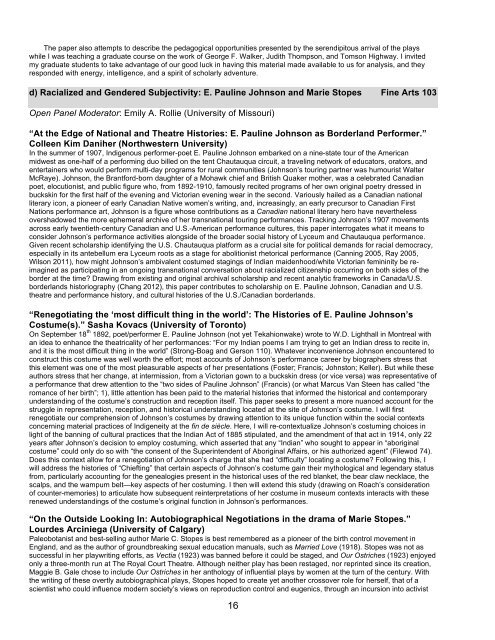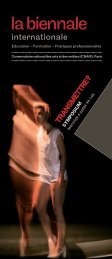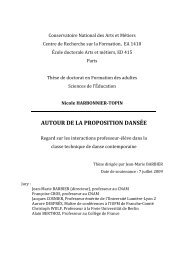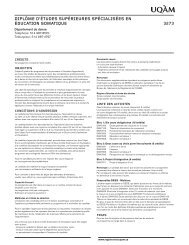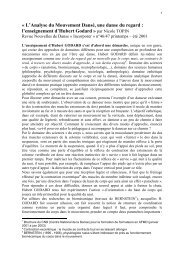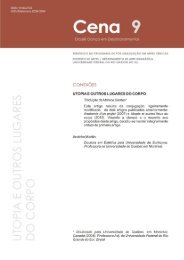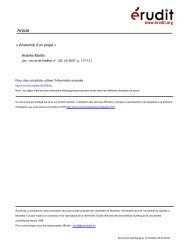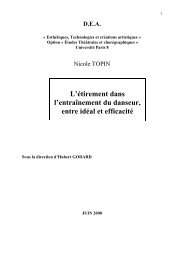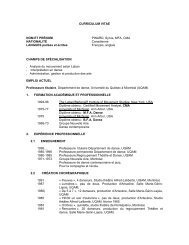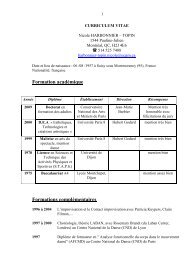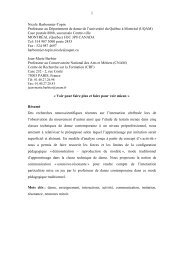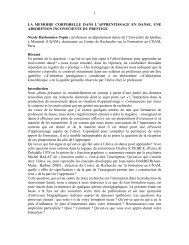Day 2 - Département de danse - UQAM
Day 2 - Département de danse - UQAM
Day 2 - Département de danse - UQAM
You also want an ePaper? Increase the reach of your titles
YUMPU automatically turns print PDFs into web optimized ePapers that Google loves.
The paper also attempts to <strong>de</strong>scribe the pedagogical opportunities presented by the serendipitous arrival of the plays<br />
while I was teaching a graduate course on the work of George F. Walker, Judith Thompson, and Tomson Highway. I invited<br />
my graduate stu<strong>de</strong>nts to take advantage of our good luck in having this material ma<strong>de</strong> available to us for analysis, and they<br />
respon<strong>de</strong>d with energy, intelligence, and a spirit of scholarly adventure.<br />
d) Racialized and Gen<strong>de</strong>red Subjectivity: E. Pauline Johnson and Marie Stopes Fine Arts 103<br />
Open Panel Mo<strong>de</strong>rator: Emily A. Rollie (University of Missouri)<br />
“At the Edge of National and Theatre Histories: E. Pauline Johnson as Bor<strong>de</strong>rland Performer.”<br />
Colleen Kim Daniher (Northwestern University)<br />
In the summer of 1907, Indigenous performer-poet E. Pauline Johnson embarked on a nine-state tour of the American<br />
midwest as one-half of a performing duo billed on the tent Chautauqua circuit, a traveling network of educators, orators, and<br />
entertainers who would perform multi-day programs for rural communities (Johnson’s touring partner was humourist Walter<br />
McRaye). Johnson, the Brantford-born daughter of a Mohawk chief and British Quaker mother, was a celebrated Canadian<br />
poet, elocutionist, and public figure who, from 1892-1910, famously recited programs of her own original poetry dressed in<br />
buckskin for the first half of the evening and Victorian evening wear in the second. Variously hailed as a Canadian national<br />
literary icon, a pioneer of early Canadian Native women’s writing, and, increasingly, an early precursor to Canadian First<br />
Nations performance art, Johnson is a figure whose contributions as a Canadian national literary hero have nevertheless<br />
overshadowed the more ephemeral archive of her transnational touring performances. Tracking Johnson’s 1907 movements<br />
across early twentieth-century Canadian and U.S.-American performance cultures, this paper interrogates what it means to<br />
consi<strong>de</strong>r Johnson’s performance activities alongsi<strong>de</strong> of the broa<strong>de</strong>r social history of Lyceum and Chautauqua performance.<br />
Given recent scholarship i<strong>de</strong>ntifying the U.S. Chautauqua platform as a crucial site for political <strong>de</strong>mands for racial <strong>de</strong>mocracy,<br />
especially in its antebellum era Lyceum roots as a stage for abolitionist rhetorical performance (Canning 2005, Ray 2005,<br />
Wilson 2011), how might Johnson’s ambivalent costumed stagings of Indian mai<strong>de</strong>nhood/white Victorian femininity be reimagined<br />
as participating in an ongoing transnational conversation about racialized citizenship occurring on both si<strong>de</strong>s of the<br />
bor<strong>de</strong>r at the time? Drawing from existing and original archival scholarship and recent analytic frameworks in Canada/U.S.<br />
bor<strong>de</strong>rlands historiography (Chang 2012), this paper contributes to scholarship on E. Pauline Johnson, Canadian and U.S.<br />
theatre and performance history, and cultural histories of the U.S./Canadian bor<strong>de</strong>rlands.<br />
“Renegotiating the ‘most difficult thing in the world’: The Histories of E. Pauline Johnson’s<br />
Costume(s).” Sasha Kovacs (University of Toronto)<br />
On September 18 th 1892, poet/performer E. Pauline Johnson (not yet Tekahionwake) wrote to W.D. Lighthall in Montreal with<br />
an i<strong>de</strong>a to enhance the theatricality of her performances: “For my Indian poems I am trying to get an Indian dress to recite in,<br />
and it is the most difficult thing in the world” (Strong-Boag and Gerson 110). Whatever inconvenience Johnson encountered to<br />
construct this costume was well worth the effort; most accounts of Johnson’s performance career by biographers stress that<br />
this element was one of the most pleasurable aspects of her presentations (Foster; Francis; Johnston; Keller). But while these<br />
authors stress that her change, at intermission, from a Victorian gown to a buckskin dress (or vice versa) was representative of<br />
a performance that drew attention to the “two si<strong>de</strong>s of Pauline Johnson” (Francis) (or what Marcus Van Steen has called “the<br />
romance of her birth”; 1), little attention has been paid to the material histories that informed the historical and contemporary<br />
un<strong>de</strong>rstanding of the costume’s construction and reception itself. This paper seeks to present a more nuanced account for the<br />
struggle in representation, reception, and historical un<strong>de</strong>rstanding located at the site of Johnson’s costume. I will first<br />
renegotiate our comprehension of Johnson’s costumes by drawing attention to its unique function within the social contexts<br />
concerning material practices of Indigeneity at the fin <strong>de</strong> siècle. Here, I will re-contextualize Johnson’s costuming choices in<br />
light of the banning of cultural practices that the Indian Act of 1885 stipulated, and the amendment of that act in 1914, only 22<br />
years after Johnson’s <strong>de</strong>cision to employ costuming, which asserted that any “Indian” who sought to appear in “aboriginal<br />
costume” could only do so with “the consent of the Superinten<strong>de</strong>nt of Aboriginal Affairs, or his authorized agent” (Filewod 74).<br />
Does this context allow for a renegotiation of Johnson’s charge that she had “difficulty” locating a costume? Following this, I<br />
will address the histories of “Chiefting” that certain aspects of Johnson’s costume gain their mythological and legendary status<br />
from, particularly accounting for the genealogies present in the historical uses of the red blanket, the bear claw necklace, the<br />
scalps, and the wampum belt—key aspects of her costuming. I then will extend this study (drawing on Roach’s consi<strong>de</strong>ration<br />
of counter-memories) to articulate how subsequent reinterpretations of her costume in museum contexts interacts with these<br />
renewed un<strong>de</strong>rstandings of the costume’s original function in Johnson’s performances.<br />
“On the Outsi<strong>de</strong> Looking In: Autobiographical Negotiations in the drama of Marie Stopes.”<br />
Lour<strong>de</strong>s Arciniega (University of Calgary)<br />
Paleobotanist and best-selling author Marie C. Stopes is best remembered as a pioneer of the birth control movement in<br />
England, and as the author of groundbreaking sexual education manuals, such as Married Love (1918). Stopes was not as<br />
successful in her playwriting efforts, as Vectia (1923) was banned before it could be staged, and Our Ostriches (1923) enjoyed<br />
only a three-month run at The Royal Court Theatre. Although neither play has been restaged, nor reprinted since its creation,<br />
Maggie B. Gale chose to inclu<strong>de</strong> Our Ostriches in her anthology of influential plays by women at the turn of the century. With<br />
the writing of these overtly autobiographical plays, Stopes hoped to create yet another crossover role for herself, that of a<br />
scientist who could influence mo<strong>de</strong>rn society’s views on reproduction control and eugenics, through an incursion into activist<br />
16


